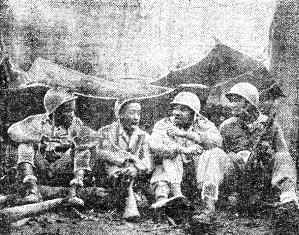
VOL. II NO. 25 REG NO. L5015 DELHI, THURSDAY MARCH 2, 1944
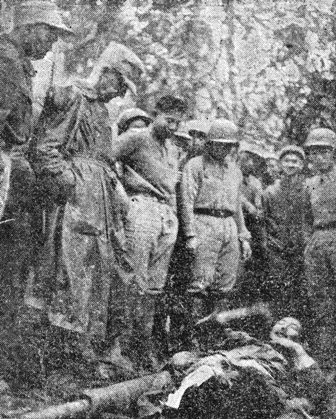 Here's a picture to prove that all Japanese aren't quick to commit hari-kiri when they're captured. This fellow,
taken prisoner by Lt. Gen. Joseph W. Stilwell's Chinese forces in Northern Burma, grins ruefully at Uncle Joe at a
jungle headquarters. He attempted to shake hands with the general but the CBI commander saw no reason for social
amenities. The Nip was given a cigarette by one of his Chinese captors and looked relieved that - for him - the war
is over.
Here's a picture to prove that all Japanese aren't quick to commit hari-kiri when they're captured. This fellow,
taken prisoner by Lt. Gen. Joseph W. Stilwell's Chinese forces in Northern Burma, grins ruefully at Uncle Joe at a
jungle headquarters. He attempted to shake hands with the general but the CBI commander saw no reason for social
amenities. The Nip was given a cigarette by one of his Chinese captors and looked relieved that - for him - the war
is over.
|
CHINESE CONSOLIDATE 60-MILE FRONT
IN NORTHERN BURMA CAMPAIGN
Japanese Base At Maingkwan Next Objective
NORTHERN BURMA - Another important phase in the Northern Burma campaign of Lt. Gen. Joseph W. Stilwell's American-trained Chinese troops was completed this week and fit itself neatly into the pattern of the drive to wrest the Hukawang and Dalu (Taro) Valleys from the Japanese.
There were conclusive Chinese successes everywhere in the scattered jungle fighting, but the most significant victory was won in the Hukawng Valley at Lakyen Ga, firmly astride the Taipha Ga-Maingkwan Road and forming an eastern anchor of the twisting trail across the spine of the Wantuk Mountains from the Dalu Valley. Seizure of the village meant that a 60-mile front, running generally east-west, had been consolidated and more than 300 square miles of enemy territory taken within a three-week period.
ONLY PART OF PICTURE
But that is only part of the picture. What is also significant is that the Chinese killed Japs, wherever and wnenever they met. Stilwell reported in mid-week that over 1,000 enemy had met death since the Hukawng campaign opened less than four months ago. But since the general's statement, communiques have increased this toll, while hundreds more of Tojo's troops are encircled and face the stark prospects of a similar fate.
Following the capture of Lakyen Ga and with it, Tsumhpawng Ga and Yawngbang Ga, the three forming a tight triangle south of Taipha Ga, the Chinese have started moving south towards Maingkwan, main Jap bastion in the Hukawng Valley. The Nips contested possession of the triangle bitterly in counter-attacks and with artillery, but they were repulsed, pocketed and wiped out. The final counter-attack was made against Yawngbang Ga, southwestern corner of the triangle, but the Japs were driven beyond previously prepared positions, leaving 164 dead behind as compared with the loss of only two Chinese.
RESISTANCE STIFFENS
Stilwell's forces are now en route to Mungwan southward along the Taipha Ga-Maingkwan Road where it is cut by the Numgawn River, six miles north of of Maingkwan. During the last two days, resistance near Mungwan has stiffened and the advance slowed. But evidence of the difficulty encountered by the enemy in his retreat at this point is starkly apparent in the unburied dead discovered along the retreat route.
The Chinese column driving southwest down the Mawning River forged four miles to the Chindwin River after taking La-awng Ga and converged with another force which had crossed the river at Taipha Ga and cut south along the opposite bank. Meanwhile, east of Taipha Ga up the Mawning another element consolidated recent advances and killed a considerable number of Japs in the cleanup of the area composed of Tumhpang Ga, Singlung Ga, La-awn Ga and Chenam Ga, the latter the last Jap-held town along the river.
Other elements of the same force cut south to the banks of the Tawang River, about five miles east of Nhkang Kyang, where contact with the enemy had been made the day before.
East of the Chindwin and Lakyen Ga and south of Taipha Ga, other units of the 38th Division advanced from Lamawn Ga southeast to successively take Tinkrai Ga and Ritu. They then stormed Taring Ga on the Tawang River, captured the village, forced a crossing over a foot bridge constructed under fire by Chinese engineers, seized a beachhead on the south bank and then cut east three miles and occupied Hkawn Gahtawng.
The Chinese drive south from the Mawning River is significant in that Stilwell's forward positions have advanced seven miles to the Tawang River, bringing them abreast of the Chinese 22nd Division west of the Chindwin.
There was less action in the Dalu Valley. Sixty enemy were ambushed fleeing east along the Ahawk River Trail, and these were presumed to be the only remnants of the enemy trapped east of Taro. Chinese patrols probed 15 miles south of Taro before contacting Japanese in small number near the Tapa River. This means the valley is now cleared of the enemy.
Ratio of dead is heavy toward the Jap part of the scale in the savage jungle warfare. Recently the enemy incurred 164 killed during one two-day period while Stilwell's troops were losing only two. Precision of timing plus the element of surprise, were credited in large part with these incredible figures.
Til Durdin, New York Times correspondent reports that the current engagements are fresh examples of the tactics the Chinese are mastering, resulting in swift movements around the Japanese flanks and rear - tactics which have resulted in the trapping of many an entire enemy detachment.
14TH A.F. THROWS JAPS YANGTZE SWIM PARTY
14TH A. F. HQ. - Mr. Tojo got a royal ducking from the 14th Air Force when Lightnings, sweeping the Yangtze River from Chihchow to Pengtheh, destryed 15 sampans and damaged one 75-foot double-decked ferry boat, five 75-foot tugs pulling barges loaded with either iron ore or coal, three 75-foot river steamers and five 50-foot motor launches.
|
While the Japs were still wiping the water out of their eyes, Mitchells, including those of the Chinese-American Wing, with fighter escort, bombed Keukiang in Central China. On the way back from this raid, eight Japanese intercepted the bombers. One was destroyed, while the other unfortunates were damaged. In the running fight, one of the Mitchells suffered minor damage.
Just in case Mr. Jap had forgotten his ducking of the day before, Mitchells again hit the Yangtze, sinking two 50-foot motor launches and damaging a 350-foot river freighter. At the same time, Hongay, in French Indo-China, was plastered by other bombers. Buildings, loading equipment and rail installations were destroyed or severely damaged. Fighter-bombers finished up the day's work by attacking Campha Port, also in French Indo-China. One aircraft failed to return.
On Feb. 27, Jap-held installations at Nam Dinh, French Indo-China, were bombed, severely damaging a railroad bridge. A 100-foot river steamer was sunk when the bombers hit Vu Ban.
In Central China, fighter-bombers attacked a rail bridge at Puchi, destroying one span and putting the bridge out of commission. All aircraft returned from these missions.
LIGHTNING STRIKES JAPS IN BURMA
A deadly package of serial trouble for the Japanese, a welcome addition to the Eastern Air Command - that's the P-38 Lightning, most versatile and ubiquitous of all Uncle Sam's single-seated fighters.
Today the Roundup takes you through the medium of Cpl. Ed Jankowski's Army Signal Corps photos, to visit one of the Assam-based squadrons. The unit's history is as yet in its infancy, but already it is satifying reading. Only a few weeks after activation, it jumped into the big leagues when it escorted bombers over Rangoon in a flight that ate up 1,200 round-trip miles for what may be a new Air Corps record and engaged in a fierce scrap with Zeros, as well. It has accomplished other tasks, too, besides tediuos escaort missions.
For instance, the squadron payed a belated Christmas visit Dec. 26 to the Aniskan Airdrome near Jap HQ at Maymyo, caught the enemy with his buck teeth hanging out and strafed 11 of 12 planes dispersed on the field, destroyed four, damaged three. Its only wound was a damaged wing, sustained when a pilot flew too low, prompting a ground crew G.I. to observe, "No wonder we surprised them - we flew through the forest."
On another occasion, the squadron's pattern of attack was enlarged when two river bridges were dive-bombed along the important Prome-Taungup supply road. One was knocked out, the other damaged and then the length of the artery savagely strafed.
Maj. John E. Fouts, Jr., of Texas, is the squadron commander, a veteran of 60 combat missions and over 300 combat hours. Most of his pilots are former enlisted men (Lt. Robert Hargis, of Warren, Ark., served for a year as an infantryman in the Aleutians) and the unit represents 43 of the 48 States and several Territories.
To date, the squadron has completed more than 40 combat missions and, although some of the pilots were introduced to the P-38 just prior to joining the unit, they unanimously commend the all-around job the Lightning can perform as a fighter and fighter-bomber. The plane is ideal as a high-altitude fighter because of its unexcelled climbing and diving speed, admirable as a bomber because of its lack of torque. Its range is long; it can take punishment; and it possesses strong firepower.
And the men who fly it in CBI-land have proven they have what it takes.
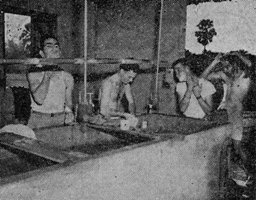 Early in the morning, Lts. Oscar Garland, Harry Warden, Douglas Yonk and Anthony Greco wash the sleep out of their
eyes, start a new day.
Early in the morning, Lts. Oscar Garland, Harry Warden, Douglas Yonk and Anthony Greco wash the sleep out of their
eyes, start a new day.
|
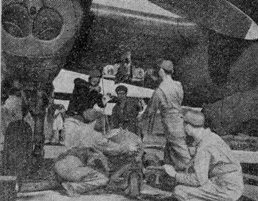 S/Sgt. James Williams, T/Sgt. Bill Griffen, Cpl. Bill Nelson, S/Sgt. Nick Udorvich and Pfc. Walt Mansell load a
powerful 1,000-pound bomb.
S/Sgt. James Williams, T/Sgt. Bill Griffen, Cpl. Bill Nelson, S/Sgt. Nick Udorvich and Pfc. Walt Mansell load a
powerful 1,000-pound bomb.
|
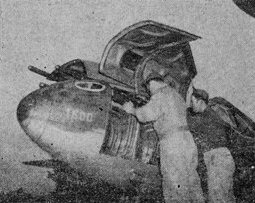 Giving a P-38 a sting, Pfc. Carmen DeStefano and Pvt. William Wallach, armorers, install a 50 calibre machine
gun in their "baby."
Giving a P-38 a sting, Pfc. Carmen DeStefano and Pvt. William Wallach, armorers, install a 50 calibre machine
gun in their "baby."
|
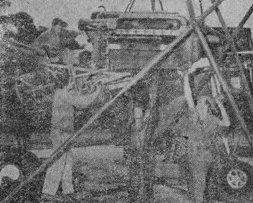 Jap ack-ack messed up an engine, but Cpl. George hartman, Sgt. Bruce Bishop and S/Sgts. Rex Jonas and Joe Swain
replace it with another.
Jap ack-ack messed up an engine, but Cpl. George hartman, Sgt. Bruce Bishop and S/Sgts. Rex Jonas and Joe Swain
replace it with another.
|
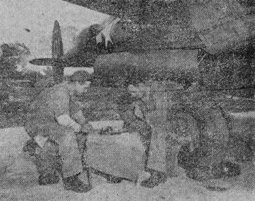 Work's done, so Cpl. Martin Dunlap and S/Sgt. G. Thompson match wits in a rugged game of chess beneath a wing.
Work's done, so Cpl. Martin Dunlap and S/Sgt. G. Thompson match wits in a rugged game of chess beneath a wing.
|
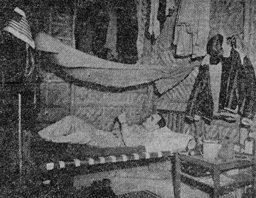 Lt. F. Distelzweig enjoys all the comforst of home, sweet home, as he reclines on his sack reading a sugar report
from Stateside.
Lt. F. Distelzweig enjoys all the comforst of home, sweet home, as he reclines on his sack reading a sugar report
from Stateside.
|
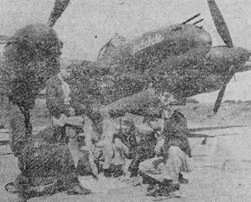 Lt. John Morton, Intelligence Officer, imparts important pre-mission information to Lts. Smith, Fertig, Norton,
Harris and Sealy.
Lt. John Morton, Intelligence Officer, imparts important pre-mission information to Lts. Smith, Fertig, Norton,
Harris and Sealy.
|
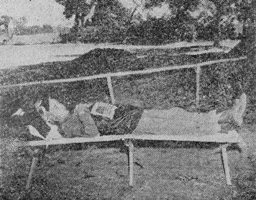 Lt. Douglas Yonk, using his 'chute for a pillow, grabs a siesta in the shade, while waiting for take-off time for
a mission over Burma.
Lt. Douglas Yonk, using his 'chute for a pillow, grabs a siesta in the shade, while waiting for take-off time for
a mission over Burma.
|
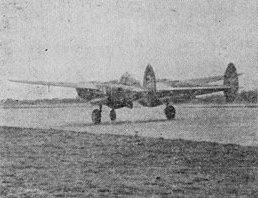 The lead plane leaves home to pay an unsocial call to the Japanese somewhere in Burma that will be most unwelcome
to the enemy.
The lead plane leaves home to pay an unsocial call to the Japanese somewhere in Burma that will be most unwelcome
to the enemy.
|
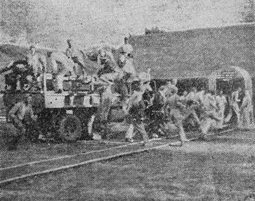 Chow call means that a truck will rumble to the field to bring the ground crews back to the mess hall to satisfy
their innards.
Chow call means that a truck will rumble to the field to bring the ground crews back to the mess hall to satisfy
their innards.
|
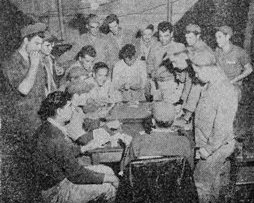 Favorite game of chance at this base is blackjack. You pull up your chair, put your rupees on the table and hope
for the best.
Favorite game of chance at this base is blackjack. You pull up your chair, put your rupees on the table and hope
for the best.
|
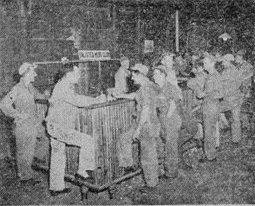 There's just time for a nightcap at the enlisted men's bar before hitting the bunk. The motif is bamboo, bar rail
and all, at this establishment.
There's just time for a nightcap at the enlisted men's bar before hitting the bunk. The motif is bamboo, bar rail
and all, at this establishment.
|
DETAILS OF P-70 TOLD TO PUBLIC
SANTA MONICA, CALIF. - The first details of the deadly effectiveness of the Douglas P-70 night fighter were revealed when the Douglas Aircraft Corp. disclosed that the plane carries four 20mm cannons.
A closely guarded Army secret for over a year, the P-70 is an adaptation of the Douglas A-20, which War Department spokesmen classified as the fastest of all bombers with the exception of fighters equipped to carry light bomb loads.
Entertainment Tour Scheduled To Open For China G.I.'s
By the time this journalistic effort greets your eyes, La Goddard, William Gargan, Andy Arcari and Keenan Wynn will already have been entertaining G.I.'s on the China side of the Hump, wrestling with the intricacies of chopsticks and discovering, no doubt, that CBI-land is appreciative of their visit to our happy community.
That the troupe lingered in "Little Washington" only long enough to receive its itinerary and to send its rumpled clothing to the dhobie walla is in keeping with the Theater policy of "entertaining the guys in the weeds first," as was the case with cavern-mouthed Joe E. Brown, Harry Barris, Mike Frankovich and Don Barclay when this quartet forsook the sheltering shores of Shangri La.
VISIT BY JAPS
Gargan, Arcari and Wynn entertained for an hour at the service club. This was staged impromptu, however, so they could brush up on their act and test crowd reaction.
Arcari, dead-panned piano accordian squeezer, is no Johnny-come-lately at entertaining overseas servicemen. Behind him are trips to the Southwest Pacific and Labrador. At Lae, he leaped, but quick, into a slit trench when Jap bombers paid an unsocial visit and left calling cards in the form of bombs. "It was very interesting," he observed, which is a masterpiece of understatement.
La Goddard. Ah, there's a gal. She'll prove herself a swell trouper. A day after her arduous six-day trip from Shangri La, she was bouncing around, anxious to get into action, as were Gargan, Arcari and Wynn.
Wynn is happy to be overseas. He recounted how one of his performances was greeted in Camp Roberts, Calif. A scattering of only 2,000 G.I.'s filed into the huge amphitheatre. Applause was lukewarm, despite the fact that Wynn's patter was effervescent.
"What went wrong?" he asked the post Special Service Officer afterwards.
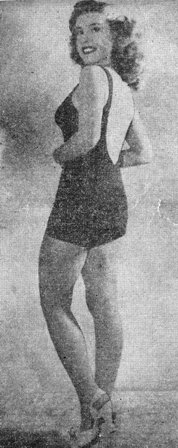 Her mama - stage favorite Mrs. Carter DeHaven - was a pin-up girl during World War I. MGM's Gloria DeHaven is a second-generation edition. Gloria has established a record for pin-up titles and outstripped her mother (figuratively), with 68 bestowed upon her by various service units.
Her mama - stage favorite Mrs. Carter DeHaven - was a pin-up girl during World War I. MGM's Gloria DeHaven is a second-generation edition. Gloria has established a record for pin-up titles and outstripped her mother (figuratively), with 68 bestowed upon her by various service units.
|
"Well, it was a bad night," apologized the SSO. "There's a world premeire movie at all the theaters in camp. Two star out-of-town basketball teams are playing in the auditorium. Glenn Miller's band is somewhere else on the post. And there's a play showing, too."
DECISION MADE
Just about this time, Wynn, son of Ed Wynn, decided that he could entertain servicemen better by going overseas.
It was disclosed that entertainers shipping overseas are now not told where they're headed until they are actually on their way. An hour out of Shangri La, La Goddard, Gargan, Arcari and Wynn were informed that CBI-land was their destination. They weren't disappointed.
Their show is fast moving, earthy corn, which, according to Wynn, is as it should be. "Soldiers don't want flag-waving, sentimental slush," he theorized. "They want to laugh. We'll give 'em as many laughs as we can." Most of the routine is borrowed from burlesque, although it is true that there will be no strip-tease act. They rehearsed it in the plane en route to this neck of the world and had the crew and passengers in stitches.
EAC WALLOPS NIPS HARD
The Eastern Air Command put the boots to Burma this week. Nineteen bridges were destroyed or severely damaged, runways of seven airfields were ripped up, five ammunition dumps were blown sky-high, two radio stations were demolished, 30 warehouses and 20 railway barges were blitzed, and a factory, a power-house and five oil installations or supply dumps were burned. In addition, more than 15 Japanese camp and headquarters areas, including two important bodies of troops, were bombed and strafed, not counting the concentrated damage in the Arakan.
Too many objectives were smeared to go into a detailed account of the week's damage. RAF, IAF and U.S. fighters, fighter-bombers and medium bombers of the Tactical Air Force swarmed in an arc from Akyab to the Hukawng valley, while the medium and heavy bombers of the Strategic Air Force, in day and night raids, pelted the more substantial targets as far east as Moulmein and Martaban.
LOCOMOTIVES HIT
In a sweep on Tangon and Pintha on Feb. 28, on the line north of Mandalay, U.S. medium bombers smashed four locomotives and 26 cars and set afire the railway stations and several warehouses at Zigon.
Twin-engined fighters of the RAF, attacking communications in South and Central Burma, hit sections of an oil pipeline, sending flames and smoke up to 1,000 feet. In the Myitkyina area, U.S. fighter-bombers hit the power station, an ammunition warehouse and rail intersections while another large formation battered railway stations, warehouses and rolling stock ay Ye-U and Tindeinyan on Feb. 27.
NIGHT ATTACK
On the night of Feb. 27-28, RAF mediums caused explosions and fires in the rail yard at Pegu in Southern Burma. RAF heavies tore up runways and dispersals in Zayatkwin, starting fires there and at Mingaladon airfield, north of Rangoon, U.S. mediums of the Strategic Air Force on Feb. 28 destroyed two spans of the Pantoin rail bridge and twisted the entire structure. Twin-engined fighters of the RAF shot up a road convoy and left a factory in flames at Zigon.
On the night of Feb. 23-24, both U.S. and RAF heavy bombers raided Moulmein and Mataban scoring numerous hits on rail sidings, a railway station and engine sheds. U.S. heavies on the 23rd scored hits on the runways and intersections on the airfields at Akyab and nearby Dabaing. The day before, the mediums destroyed a canal bridge and a river bridge at Ye-U, kayoed a span of the Bunalin bridge, set an oil dump afire and destroyed several warehouses while fighter-bombers damaged the railroad bridge at Namkwin, destroyed the bridge at Loiaw and caused many fires and extensive damage in a bivouac area and ammunition dump on the Kamaing-Manywet road.
Burma Death Sixth In Georgia Family
Lt. Nick Zadorkin, killed recently in Burma, was disclosed this week by Army News Service to be the sixth member of his immediate family to lose his life in action.
ANS reported that in Atlanta, Ga., his sister, Mrs. Helen Connor, reported to a riveting school as usual after learning of his death.
Others of Mrs. Connor's family to die in this war have been her son, William, in Tunisia; her husband, W. J. Connor, in the Marshalls; her sister, Vera, killed while piloting a ferry plane; a brother, Alex, in North Africa, and another brother, Mike, in the Pacific.
COURAGE IN JUNGLE WAR
BURMA RIVER CROSSING EFFECTED AFTER SCREENED POSITION RECONNOITERED
By ARCH STEELE Chicago Daily News Correspondent
WITH THE CHINESE ARMY, NORTHERN BURMA - We stood on the river bank and watched one of those little incidents of jungle warfare that gives you faith in the guts and initiative of the American fighting man.
For weeks, Japanese and Chinese had been pot-shooting at each other across that crucial crossing, but for two days there had been no firing from the enemy shore. Nobody was quite sure whether the Japs had retreated or were still hidden behind the opaque screen of jungle foliage that came down to the water's edge on the opposite side of the 200-yard wide stream. There was only one way to find out.
LIEUTENANT VOLUNTEERS
Lt. Leland griffin, of Ocean City, Md., volunteered to wade to the other bank, taking two men with him. Machine guns and light cannon manned by boyish, apple-cheeked Chinese soldiers, were put in place to return fire in case of sniping or ambush. Armed only with carbines, Griffin, accompanied by Sgt. Frank Brosch, of Chicago, and Sgt. Martin W. Rushing, of Bruceton, Tenn., splashed laboriously across the strip of water - perfect targets for any concealed enemy troops on the other side. There was a moment of tension when a tree crashed noisily on the opposite bank and another when a monkey leaped from one tree to another. But no shot was fired. The Japs had certainly withdrawn - forced back by the advance of Chinese columns on their flanks.
"Good work" was the comment when the trio had completed the two-way trip.
"Nothing to it," Brosch told me, as he was wet and grinning, "but that monkey liked to scared me to death." brosch was helping run a traveling carnival before the war.
TIRELESS ENGINEERS
A bloodless incident, but it meant we could immediately begin pushing troops and supplies across the river in pursuit of the retreating enemy. It's significant of the speed with which Lt. Gen. Joseph W. Stilwell's Engineers are building roads, trails and bridges through the Hukawng Valley on the heels of the advancing Chinese that before this crossing was made, bulldozers had already reached the spot and were ready for the next phase of the advance. Two of them stood by, their motors chugging, while their drivers, Ad Geary, Of Houston, Tex., and Virgil Greenwood, of Skiatook, Okla., watched the show. Huge caterpillar-driven road machines had been pushing dirt and pulling logs under artllery fire. Their drivers carried rifles and machine guns for self-protection. A few days before, another of their number had hit a Jap booby trap and been damaged, its driver wounded.
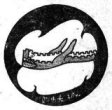
|
'GREAT WALL' UNIT OLD-NEW TEAM
CHINA AIR BASE - The "Great Wall Fighter Squadron" of the 14th Air Force combines both age and youth to add up to success in the campaign against Nippon in the skies over China.
The aga comes from their name, taken after the ancient Wall of China, one of the oldest historical symbols in the world. The flyers took this name after being presented with a silk banner by the people of a Chinese town after a sky battle. The banner's inscription reads, "To the Officers and Men of China's Great Wall in the Air."
The youth comes from the commanding officer, Maj. R. L. (Bob) Liles, who is only 23 years old. Liles has been in China since June, 1942 and has flown over 100 combat missions.
SHANGRI-LA CHRISTENED
CARRIER SPED ON WAY BY MRS. DOOLITTLE
PORTSMOUTH, VA - The memory of Shangri-La arose to plague the Japs when an aircraft carrier of that name was launched at Norfolk Naval Yard this week, with Mrs. James Doolittle, wife of the Eighth Air Force commander who led the raid on Tokyo, christening the newest offensive weapon of the Navy.
The christening was witnessed by the English novelist, James Hilton, whose creation of the mythical land, Shangri-La, in his novel Lost Horizon, led to President Roosevelt's famous phrase after the Tokyo raid, that the American bombers had come from there.
The new carrier displaces 27,500 tons, is protected by 16 5-inch guns and will carry more than 2,000 men. Its launching boosts the number of first line carriers to 14.
HEAP BIG G.I. GAME HUNTERS STALK, KILL JUNGLE KITTY
|
DATE: Recently.
TIME: Night (almost 9:30).
PLACE: A deserted, lonely stretch of road near a service center of the CBI Air Service Command.
CAST: Capts. Grover F. Nelson and Irving P. Clark and Lts. Frank L. Gentile and John Edwards (and incidental men and officers, including one nurse, blonde).
ACTION: The attack and over-coming of one small, insignificant leopard, looking for his supper. Overall length, about seven feet, weight about 150 pounds, an oh, my, what claws.
It was exciting. Gentile spots large cat. He (being a Veterinarian) identifies same as Genus Leopard and returns, post haste, to his barracks for reinforcements. Poker players show no enthusiasm. In fact, they evidence positive disbelief. Edwards, bored letter writer, consents to get a breath of fresh air, and, non-chalantly arming self with .45 and QM flashlight, sets off with eager hunter armed with double-barrelled shotgun.
Valiant warriors proceed at breakneck speed to the road, last whereabouts of Oscar (the leopard). Arrival at this point brings little hope, but farther on is a jeep, parked. Its lights shine on Lord Leopard, reposing majestically upon a bank. He calmly surveys the group of whispering, excited men.
In less time than it takes to tell, the hunter (Gentile) has dismounted, aimed and fired. The beast, obviously getting the worst of the exchange, does a flip-flop, then angles off. Our ears inform us, however, that he does not go far. Blood on the leaves tells us that he is hit, perhaps badly (we hope).
Wary but curious, various would-be Frank Bucks sweep the immediate vicinity with their torches, but no tawny body is disclosed. Suddenly, "Ah, there's more blood." They follow the gory trail with their flashlights.
But what's that? Reinforcements! Good! So Nelson with .45, Clark with rifle, Gentile with shotgun and others backing them up with lights proceed with caution into the dark forest.
"There he is."
"Where?"
"There, right there. Can't you see his spots?"
And lo and behold about eight feet away is the spotted body of the beast.
"Oh, he's dead."
"No he isn't. His tail is moving. See?"
So, after much bickering, Clark takes a shot with his rifle. The sound of the explosion is matched by the terrific roar which issues from the leopard, accompanied by much thrashing about. "Look out, here he comes!" Everyone sways back a couple of yards as though blown by a strong wind. However, he has moved somewhere else, and for several seconds the flashlights probe the brush, until someone points 10 feet to our left, where he is in his death throes.
A bullet through the head by nelson finishes the animal, but we stealthily approach the battered carcass, while Nelson keeps his pistol trained upon it. By that time, we are beginning to realize we have been a mite scared.
The beast is a heavy-built male, with terrific claws. Had he not been blinded by the first shot, he might have caused considerable embarassment for everyone concerned.
China B-24 Unit Year Overseas Walloping Japs
CHINA AIR BASE - One year of overseas duty was completed by the Liberators of China this month and the boys felt they had cause for celebration.
And celebrate they did, with good old made-in-America food available for hungry G.I.'s and with ample jingbah juice on hand for the thirsty souls.
Then too, Red Cross lassies lent their charm to the occasion, supervising preparations for the festivities and giving the all-important feminine touch to the rec halls.
It was on Feb. 15, 1943, that the good ship (censored) pulled away from the shores of sunny California, carrying with it the ground personnel of the heavy bomb group which later was to earn the title, "Liberators of China."
About the same time as the boat sailed, the B-24's of the outfit were soaring from Stateside airfields en route to join the embryo 14th Air Force in its battle against the Japs.
FIRST ARRIVALS
First arrivals were members of the air echelon late in March. About a month later, first of the ground crews were over the Hump from India, and on May 4, the "Liberators of China" flew their first combat mission.
Flying in the lead ship was Group C.O. Col. Eugene H. Beebe, former personal pilot for Gen. H. H. Arnold, Air Corps chief, and, despite the inexperience of the crews, the target was leveled.
Since that time, many mission have been flown and the ruins of Nip installations in many parts of the Orient and Tojo's ships at the bottom of the sea are testimony to the part being played by the Liberators.
During the course of the missions flown, the group's planes encountered enemy fighters on many occasions - many Zeros that will never fly again. More than 200 enemy planes have been destroyed in the air, and many more have probably been destroyed or damaged. Exact figures for those destroyed on the ground are not available, but it is believed that 28 or more have been demolished.
JAP TOLL LISTED
No effort can be made here to detail the results of bombing operations. Suffice it to say, well over two million pounds of bombs have been dropped. At least 13 ships have been sunk, and an additional 35,000 tons of shipping have been damaged. Ports and port facilities have been demolished, airfields have been blasted, warehouses have been leveled, supply dumps have been lamblasted, fuel, oil and stores have been burned, and Jap communication and transportation lines have been wrecked.
Col. William P. Fisher, veteran of the fighting in the Philippines, Australia and Java, has replaced Col. Beebe, now brigadier general with SEAC, and has proved a fighting leader.
The year has had its sad moments, for the damage to the enemy has not been accomplished without losses. While they have been remarkably light, buddies have been killed, others are missing, some wounded and a few listed as prisoners of war.
The Liberators have had their baptism under fire and look forward to their second year overseas with confidence born of the fact they have met the enemy and defeated him wherever found.
|
CHEESECAKE 'DING-HOW'
BURMA - The Oriental mind moves in conventional channels, after all.
This was proven recently when Sgt. Yu Hua Ting, commonly known as "Buttercup," took time out to take a rapid gander at a couple of pages of Roundup cheesecake.
"Buttercup" is lt. Gen. Joseph W. Stilwell's Chinese soldier orderly, No. 1 dogrobber of Northern Burma, buddy of all American officers and enlisted men and war correspondents.
The little guy, who comes from Chengtu, speaks no English other than "okay," is five feet tall, weighs 110 pounds and speaks of everything as "ding how." he has spent 15 years in the Chinese Army, has a four-year-old daughter, is a widower, but everything is ding how.
He picked up a copy of the Roundup the other day and was intently reading it upside down until he came to two pages of cheesecake, then announced: "Ding how, ding how." (Which means very good, indeed.)
"Buttercup" was obviously born for better things.
DOCK WORKERS BEND BACKS
To Place No. 1 In Ship Unloading
That SOS dock workers have been vigorously bending their backs to unload ships jammed with vital supplies there is little doubt, following a report from the Chief of Transportation, Washington, D.C., to SOS Commanding General in CBI Maj. Gen. W. E. R. Covell.
Vest buttons justifiably popped throughout the SOS structure when it was announced that SOS in CBI-land held No. 1 position in average measurement tons unloaded per day in all the far-flung overseas theaters of war. The exact figure, of course, must be clothed in military secrecy, but the percentage of bulge over the No. 2 theater was revealed as 30 percent.
The climb of the CBI in ship unloading has been steady and certain. Fourth during the first half of December, the SOS dock workers pushed up to third during the last half of the month, remained at that position during the second half of January, and then hit the jackpot.
Covell pledges that the SOS isn't going to rest upon its laurels. "The competition is keen to hold No. 1," he declared, "and we can't afford to let up."
Best Care Of Chinese In History
By TIL DURDIN New York Times Correspondent
WITH STILWELL'S CHINESE FORCES IN THE HUKAWNG VALLEY - A combination of Chinese-American Army medical services is giving the Chinese forces fighting in the Hukawng Valley the best medical attention the Chinese Army has ever had.
Hundreds of American Army doctors and enlisted men and a group of American women Army nurses are on duty here with the Chinese. Some American medical units are with the most forward Chinese troops. Others are in the rear areas, just behind the front and it is here that the American women nurses are stationed.
Medical services for the Chinese Army now fighting in Northern Burma were organized under the direction of Col. A. P. Williams, of Carmel, Calif., chief surgeon of the CBI. Under the scheme of organization, Chinese first aid personnel attend to casualties on the battlefield, dress wounds and evacuates the wounded to the rear bt stretcher. Medical and first aid personnel throughout the battalions and regiments is all Chinese, with the exception of the American medical liaison officers.
American Field Hospital units are attached to the division headquarters and it's somewhere along the trail, en route to the division or near the division, five or 10 miles from the front, that the Chinese wounded get their first complete surgical treatment.
This is an American hospital and as a rule in the hands of an American doctor. Chinese injured reach the hospital in from six to 15 hours after being wounded.
Also attached to the division are Chinese hospitals. Lightly wounded are turned over to the Chinese hospital for recuperation and return to the front, while more seriously wounded are operated on at American hospitals and, as soon as possible, sometimes within a few hours, are evacuated by river, road and airplane hundreds of miles across the Naga Hills to the big American base hospitals in Assam.
Such is the planned scheme of things. In practice here, circumstances have necessitated American portable surgical units accompanying the Chinese striking forces on special missions practically into the firing line.
Lt. Col. Gordon S. Seagrave, with his unorthodox aggregation of American doctors and enlisted medical corpsmen, Burman nurses, doctors and surgeons and civilian doctors who are refugees from Fascism, is in command of portable surgical units here that have frequently been under fire of Jap artillery and snipers while serving with the advance Chinese detachments.
Besides the Seagrave units, other regular American Army portable surgical hospitals and field hospitals are here and some at times have been almost within shouting distance of the Japanese forces. Portable, field and semi-permanent rear American hospitals in the Hukawng Valley provide expert surgeons and modern equipment for practically any type of emergency war surgery.
Many of the American Army doctors now with Chinese in the Hukawng Valley were leading practioners in their fields in civilian life, for the Chinese here have indicated the fact that deaths among casualties reaching American battle-front hospitals is running around two percent.
All of the Chinese medical personnel now with the troops in Burma have been trained at an American training center for the Chinese Army in India. Each Chinese regiment has at least one university graduate Chinese surgeon heading the medical units and there are others at division headquarters.
Blood and blood plasma for the Chinese front is obtained from a blood bank in Calcutta. A motorized blood soliciting team plys the Ledo Road regularlay, taking blood from Chinese units along the road for front line use.
Chinese first aid men at the front are not sufficiently trained to use plasma and blood transfusions at every front as is done with American soldiers within a few minutes after they are wounded. Chinese wounded get fine plasma and blood when they reach the American medical units in the field.
Pending the day when precious space on planes back to China can be spared for them, disabled Chinese soldiers are being kept contentedly busy growing vegetables for troops in big, specially organized gardens in Assam. More such gardens are to be staked out at the new convalescent camp in the Naga Hills.
U.S. War Casualties Hit Figure of 157,865
WASHINGTON - Total U.S. casualties to date in World War II are 157,865, including 36,055 dead, according to an announcement from the Office of War Information this week.
The wounded number 54,867, the missing, 35,830, and prisoners, 31,163.
The War Department showed 118,128 total casualties as of Feb. 8 and of these 19,128 were killed, 45,545 wounded, 26,338 missing and 26,745 prisoners. Navy casualties as of Feb. 24 were 16,506 dead, 9,322 wounded, 9,491 missing and 4,418 prisoners.
CIVILIANS ASKED FOR 'V' GARDENS
DETROIT - Marvin Jones, War Food Administrator, asked civilians to plant 22,000,000 Victory Gardens to grow 10,000,000 tons of food, saying: "We cannot afford to relax the nation's fullest attention to this share of our total food supply."
Last year the government asked for 15,000,000 gardens and got 20,000,000, which produced nearly 40 percent of the vegetables grown for home use and were largely responsible for the satisfactory supply of canned vegetables this winter.
|
G.I. JUNGLE RHYTHM
Serenade CBI Theater Boss
BURMA - One night, Lt. Gen. Joseph W. Stilwell walked quietly from his jungle basha and sat down under a tree listening to a Negro soldier quartet who didn't know he was around.
They were members of a colored Engineer unit that was passing down the Hukawng Valley towards the front. Their music was so excellent that The Boss listened for over an hour and requested some Hawaiian numbers.
The four - Sgt. Albritton, Kinston, N.C.; Cpls. Joe Jacob, Plant City, Fla., and Frederick Barrow, Chicago; and Pfc. Frank Method, Rommey, W.Va. - call themselves the "Four Notes In Harmony." They have been singing together for four months, mostly to Chinese and Kachin audiences.
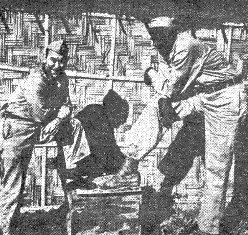
|
LONG AND SHORT OF IT
Anything Can Happen In Texas
ASSAM BASE - The fact that Texas is a state where anything can happen has been amply impressed on the Quartermaster outfit of this base, the harried members of which face the problem of attempting to find shoes that fit two different G.I.'s who were born and brought up only a rope's throw from each other in the Lone Star State.
One of them, Pvt. Clyde Duffey, requires a size 16 brogan to encase the pedal extremities which support his seven-foot-two height, while the other, Sgt. Thomas A. Zeloski, goes clear to the opposite extreme by demanding of the harried QM's no more than a four and one-half double E.
Duffey was turned down three times by his draft board because his height exceeds the Army's six-foot-six maximum, but finally made it, much to the distress of the lads who are responsible for clothing him. The only way out was to have both his shoes and his clothes tailor-made, which gives Duffey a rare distinction in this man's Army.
Duffey also claims to be the tallest man in the U.S. Armed Forces and, to date, he has never run into anyone even able to give him an argument on the subject.

By LT. RICHARD T. McCLAUGHRY
ADVANCED EVACUATION HOSPITAL - In spite of the seriously important objectives involved, the world at large probably is hearing very little - and understanding less - about the fighting now going on in the Hukawng Valley.
So far as the number of men engaged is concerned, this is small potatoes compared with the battles in Russia or in the Marshalls or in the skies over Europe.
But, as Lt. Gen. Joseph W. Stilwell recently pointed out, any action is the most important in history to the man who gets shot in it.
This week, we talked to some who did.
They had strange names. Strange, that is, to American ears. From the occidental viewpoint, their skin had a strange color, their eyes were set a little strangely in their broad, high-cheekboned faces, and the language they spoke was strangest of all.
But the enemy they had been fighting was one which has not been strange to America since Dec. 7, 1941. Neither were the weapons with which they fought, nor the tactics they used, nor the officers who planned their campaign. For these were the early casualties among the Stilwell-commanded, American-trained and equipped Chinese troops, who are fighting the Burma-based Japs to make room for an American-engineered road through British territory as a life-line to China. And the honorable wounds they received in battle are being tended by American hands.
We saw them at the Blank Evacuation Hospital, somewhere on the Ledo Road. To be frank about it, this was the first time we ever saw battle casualties of any nationality. It was the first time, so far as we know, we ever talked to native-born Chinese, and it all had to be done through interpreters.
We don't quite know what we expected, but whatever it was, we didn't find it. Except for a few who lay quietly - the most serious cases - a general atmosphere of what can best be described as festivity seemed to prevail in the wards we visited. Personally, after looking at the wounds of some of the "festive" ones, or at X-ray photos of what had happened to arms or legs or bodies swathed in plaster casts, we feel sure the word "festive" would not have described the way we'd have felt if it had happened to us.
THE CASE OF CHUNG WOO-YUN
There was, for instance, the case of Chung Woo-Yun, who proudly exhibited the now almost healed scar which once had been a jagged, gaping wound in one of his legs. We asked, through an interpreter, how he got it. His answer was a model of brevity which could serve as an inspiration for the most clear, curt and complete American newswriter. Sitting up in bed and holding his hands and arms in the position of a sniper holding a rifle, "Japaneezy . . Boom! . . Boo How!" said Chung Woo-Yun. His face beamed contentedly.
Incidentally, Hong Kong born Chung, who is now 22, is a veteran of seven years' service with Generalissimo Chiang Kai-shek's army, and of three major campaigns. He was wounded once before, in the battle of Shanghai.
Another wounded man with whom we talked was Liu Kai-Wa, of Szechewan Province, who had not long ago had his left leg amputated near the hip. Like Chung, he seemed neither impressed nor depressed. He agreed, however, that it was boo how.
On the other hand, a lot of things were ding how with Liu. The food? Ding how. Treatment? Ding how. American nurses? Very Ding how. Japs? "They ought to have their heads cut off," said Liu, through an interpreter.
We asked about his wound, and discovered that it was the result of a Japanese hand grenade, thrown as Liu and other members of his unit were attacking an encircled Jap machine gun nest. "It didn't hurt at all for a long time," said Liu. "Later - American doctors." And his opinion of U.S. Army medicos was expressed emphatically, again in a laconic and ever-recurring ding how.
Just then, dinner was served in the ward. It looked unfamiliar, but good. Interrogation produced the information that it was rice, plus a stew containing mainly of corned willie and potatoes to which something had an added pink color. Unlike American troops, to Chinese corned willie is also ding how. And there was bread - white, American bread and plenty of it. To a Chinese private, this is a miracle. In their army, bread is as much a mark of rank as collar pips, because usually only higher officers can get it.
CHINESE PATIENTS LIKE ANY OTHER
Almost coincident with dinner came an American captain in the Medical Corps, Leonard Rosoff, by name, who formerly praticed the healing arts in Los Angeles. With him was tall, clear-eyed Lt. Edythe Husuru, ANC, of Aurora, N.D., dressed in a neat blue shirt and dark blue slacks, and later we me trim Lt. Mary Land, of Cleveland, and jolly, sandy-haired Chief Dietician Camp, another Mary, of Long Beach, Calif.
We asked Capt. Rosoff how Chinese and American patients compared. "About the same," he replied, "The ones in the least trouble make the most fuss."
The nurses were more expansive. "They're fun to work with, these Chinese boys," they said, "although they get mischievious at times and develope streaks of temperament when we least expect it. But they're generally good-natured, and very lively. Whoever started that legend that Chinese are grave, inscrutable and perpetually dignified were not talking about the ones we'ver seen. These are usually the opposite."
The hospital, from its C.O. Col. Wallace N. Davidson, of Cushing, Okla., down to Medical Corps G.I.'s who are still yearning for their first stripe, is proud of the record it has set since the present fighting started - only one patient of all those who have reached the hospital alive has died of combat wounds. This is all the more remarkable in that only serious cases are sent back to this station, flown in from advanced stations in little two-seated planes from which all superfluous equipment has been removed in order to squeeze in a single stretcher per trip. Many are rushed directly from the plane to the operating table - but so far, through the speed of the plane, the skill of the doctors and the care of the nurses and G.I. attendants, the help has come in time, and many of even those very seriously wounded will some day fight again.
Which looks to us like a ding how achievement for our Medicos. But then, the Chinese fighting in the Hukawng has been ding how, too. That makes things even.
The C.B.I. Roundup is a weekly newspaper published by and for the men of the United States Army Forces in China, Burma, and India, from news and pictures supplied by staff members, soldier correspondents, the United Press, and the Army News Service. The Roundup is published Friday of each week and is printed by The Statesman in New Delhi, India. Editorial matter should be sent directly to Lt. Floyd Walter, Rear Echelon Hq., U.S.A.F., C.B.I., New Delhi, and should arrive not later than Monday in order to make that week's issue. Pictures must arrive by Sunday and must be negatives or enlargements. Stories should contain full name and organization of sender.

MARCH 2, 1944
Original issue of C.B.I. Roundup shared by Virginia Dyer, widow of CBI veteran Stanley Dyer.
Copyright © 2006 Carl Warren Weidenburner
TOP OF PAGE PRINT THIS PAGE ABOUT THIS PAGE SEND COMMENTS
PREVIOUS ISSUE CLOSE THIS WINDOW NEXT ISSUE
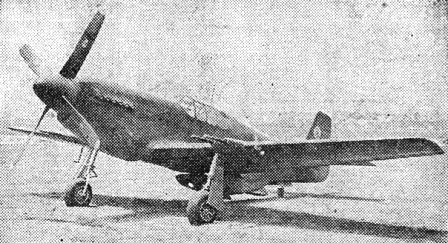 This sturdy blittle plane is an improved version of the P-51 Mustang, spunky escort fighter which now has a speed of
400 miles per hour, plus longer range, greater weight and a service ceiling of well over 30,000 feet.
This sturdy blittle plane is an improved version of the P-51 Mustang, spunky escort fighter which now has a speed of
400 miles per hour, plus longer range, greater weight and a service ceiling of well over 30,000 feet.
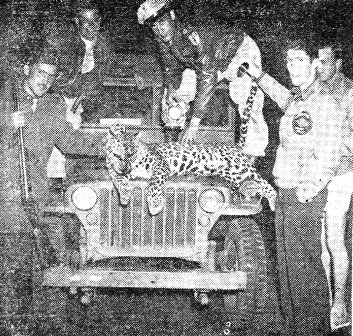 Left to right, four Frank Bucks in khaki look unconcerned into the camera: Lt. Frank Gentile, Maj. Edward Spunt,
Capt. Grover Nelson and Lt. John Edwards.
Left to right, four Frank Bucks in khaki look unconcerned into the camera: Lt. Frank Gentile, Maj. Edward Spunt,
Capt. Grover Nelson and Lt. John Edwards.
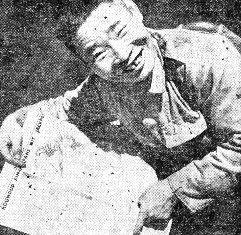 "Buttercup," effervescent Chinese orderly to Lt. Gen. Joseph W. Stilwell, radiates his approval of Roundup
pin-up girls.
"Buttercup," effervescent Chinese orderly to Lt. Gen. Joseph W. Stilwell, radiates his approval of Roundup
pin-up girls.
